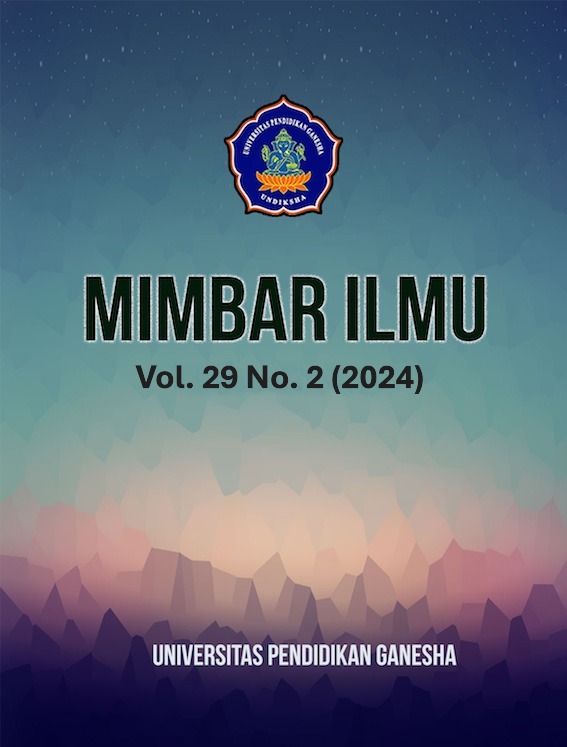Psychosocial Determinants of Substance Use among Physically Challenged Individuals in Ibadan
DOI:
https://doi.org/10.23887/mi.v29i2.78212Keywords:
Psychosocial Determinants, Alcohol and Drug Use, Physically Challenged PersonsAbstract
Substance use among physically challenged individuals poses various risks to their health and well-being, as well as to the broader community. Excessive alcohol and drug consumption can exacerbate existing health conditions and impair physical and cognitive functioning, leading to increased vulnerability to accidents, injuries, and other adverse outcomes. Therefore the aim of this study is to investigate the psychosocial determinants impacting alcohol and drug use within the physically challenged community in Ibadan. Employing a cross-sectional data collection uncovers the intricate relationship between social, psychological, and environmental factors and substance use behaviors. Results highlight the profound influence of social isolation, stigma, and limited access to support services on substance use patterns among the physically challenged in Ibadan. The findings underscore the urgency for tailored interventions and enhanced support services aimed at addressing the unique needs of this population. This study contributes valuable insights for policymakers, healthcare providers, and community organizations working to improve the quality of life for physically challenged individuals in Ibadan and similar contexts.
References
Afum, E., Sun, Z., Agyabeng-Mensah, Y., & Baah, C. (2023). Lean production systems, social sustainability performance and green competitiveness: the mediating roles of green technology adoption and green product innovation. Journal of Engineering, Design and Technology, 21(1), 206–227. https://doi.org/10.1108/JEDT-02-2021-0099.
Anderson, P., Chisholm, D., & Fuhr, D. C. (2009). Effectiveness and cost-effectiveness of policies and programmes to reduce the harm caused by alcohol. , . The Lancet, 373(9682), 2234–2246. https://www.thelancet.com/journals/lancet/article/PIIS0140673609607443/fulltext.
Bloomfield, J., & Fisher, M. (2019). Quantitative research design. Journal of the Australasian Rehabilitation Nurses Association, 22(2), 27–30. https://doi.org/https://doi.org/10.33235/jarna.22.2.27-30.
Bøe, M., Heikka, J., Kettukangas, T., & Hognestad, K. (2022). Pedagogical leadership in activities with children – A shadowing study of early childhood teachers in Norway and Finland. Teaching and Teacher Education, 117, 103787. https://doi.org/10.1016/j.tate.2022.103787.
Bolinski, F., Boumparis, N., Kleiboer, A., Cuijpers, P., Ebert, D. D., & Riper, H. (2020). The effect of e-mental health interventions on academic performance in university and college students: A meta-analysis of randomized controlled trials. Internet Interventions, 20(April), 100321.1-10. https://doi.org/10.1016/j.invent.2020.100321.
Boopathiraj, C., & Chellamani, K. (2013). Analysis of Test Items on Difficulty Level and Discrimination Index in the Test for Research in Education. International Journal of Social Science & Interdisciplinary Research, 2(2). https://citeseerx.ist.psu.edu/document?repid=rep1&type=pdf&doi=a9e08c03848e95760275e36f75cae88e49bc6c65.
Dhida, T. T. (2021). The Effect Of Animation Video Learning Media on Social Emotional Development of Early Children: A Literature Review. Early Childhood Education and Development Journal, 3(1), 47–58. https://jurnal.uns.ac.id/ecedj.
Duan, L., Shao, X., Wang, Y., Huang, Y., Miao, J., Yang, X., & Zhu, G. (2020). An investigation of mental health status of children and adolescents in china during the outbreak of COVID-19. Journal of Affective Disorders, 275(April), 112–118. https://doi.org/10.1016/j.jad.2020.06.029.
Espericueta-Medina, M. N., Sánchez-Rivera, L., Villarreal-Soto, B. M., & Ramírez-Padrón, M. Y. (2020). The importance of Self-efficacy and Resilience in the Learning Style of the University Student. ECORFAN Journal Republic of Paraguay, December 2021, 6–14. https://doi.org/10.35429/ejrop.2020.11.6.6.14.
Gana, C. S., Ugwuanyi, C. S., & Abraham Ageda MEd, T. (2019). Students’ Psychological Predictors of Academic Achievement in Physics. International Journal of Research and Innovation in Social Science, III(Ix), 2454–6186. http://repository.futminna.edu.ng:8080/jspui/handle/123456789/3963.
Huberty, J., Green, J., Glissmann, C., Larkey, L., Puzia, M., & Lee, C. (2019). Efficacy of the mindfulness meditation mobile app “calm” to reduce stress among college students: Randomized controlled trial. JMIR MHealth and UHealth, 7(6). https://doi.org/10.2196/14273.
Igbineweka, P., Sule, M., Okpa, O., Anike, M., Egbe, O., Osa, P., & Motun, E. (2020). Influence of clinical instructional supervisory practices on teachers’ professional efficiency in secondary schools in Calabar education zone, Nigeria. European Journal of Social Sciences, 60, 136–145. http://www.europeanjournalofsocialsciences.com/.
Iwamoto, D., & Chun, H. (2020). The Emotional Impact of Social Media in Higher Education. International Journal of Higher Education, 9(2), 239. https://doi.org/10.5430/ijhe.v9n2p239.
Kim, J. Y., & Kim, E. (2021). Effect of positive parenting styles as perceived by middle school students on academic achievement and the mediation effect of self-esteem and academic engagement. Sustainability, 13(23), 13233. https://doi.org/10.3390/su132313233.
Kim, Y., Dykema, J., Stevenson, J., Black, P., & Moberg, D. P. (2019). Straightlining: Overview of Measurement, Comparison of Indicators, and Effects in Mail–Web Mixed-Mode Surveys. Social Science Computer Review, 37(2), 214–233. https://doi.org/10.1177/0894439317752406.
Koban, L., Andrews-Hanna, J. R., Ives, L., Wager, T. D., & Arch, J. J. (2023). Brain mediators of biased social learning of self-perception in social anxiety disorder. Translational Psychiatry, 13(1), 292. https://doi.org/10.1038/s41398-023-02587-z.
Kougiali, Z. G., Soar, K., Pytlik, A., Brown, J., Wozniak, K., Nsumba, F., Wilkins, T., Oliva, E., Osunsanya, S., Clarke, C., Casalotti, S., & Pendry, B. (2020). Jigsaw Recovery: The Spatio-temporalities of Alcohol Abuse and Recovery in a Non-interventionist, Peer-led Service. Alcoholism Treatment Quarterly, 38(2), 165–183. https://doi.org/10.1080/07347324.2019.1686960.
Kudinov, S. I., Kudinov, S. S., Mikhailova, O., Kudinov, V. S., & Imomberdieva, N. M. (2020). Different self-attitude indicators in students and their self-realization in a university. International Journal of Cognitive Research in Science, Engineering and Education, 8(3), 47–59. https://doi.org/10.23947/2334-8496-2020-8-3-47-59.
Magomedkhan, M. M., & Sadovoy, A. N. (2021). Ethno-social consequences of the depopulation of mountain regions: Dagestan and North Ossetia. In History, Archeology and Ethnography of the Caucasus (Vol. 17, Issue 2). https://doi.org/10.32653/CH172507-522.
Melizsa, Sopian, A., Dewantoro, A., Wijanarko, D. A. W., Koswara Rahajeng, S., Senjaya, A., Arnitha, B., Parida, A., Rahmawati, A., Afifah, T., & Al-anshory, Z. M. (2021). The Importance of Mental Health in Children and Adolescents in Parakan Inpres Village Selatan Tangerang. Jurnal Abdi Masyarakat, 2(2), 115–123. https://doi.org/10.52031/jam.v2i2.219.
Nguyen, D. T., Wright, E. P., Dedding, C., Pham, T. T., & Bunders, J. (2019). Low Self-Esteem and Its Association With Anxiety, Depression, and Suicidal Ideation in Vietnamese Secondary School Students: A Cross-Sectional Study. Frontiers in Psychiatry, 10(1), 1–7. https://doi.org/10.3389/fpsyt.2019.00698.
Nilamsari, N., Noviarni, F. S. I., & Damayanti, R. (2019). The Effort To Increase Awareness Safety And Health At Schools For Elementary Schools Student Using Role Play Method. Darmabakti Cendekia: Journal of Community Service and Engagements, 1(1), 22. https://doi.org/10.20473/dc.V1.I1.2019.22-27.
Odeleye, B.-G., & Santiago, J. (2019). A Review of some Diverse Models of Summer-Bridge Programs for First-Generation and At-Risk College Students. Administrative Issues Journal Education Practice and Research, 9(1), 35–47. https://doi.org/10.5929/9.1.2.
Pasay-an, E., Magwilang, J. O. G., Pasay-an, E., Magwilang, J. O. G., & Pangket, P. P. (2020). Knowledge, attitudes, and practices of adolescents regarding sexuality and reproductive issues in the Cordillera administrative region of the Philippines. Makara Journal of Health Research, 24(3), 164−172. https://doi.org/10.7454/msk.v24i3.1245.
Pitnawati, Damrah, Handayani, S. G., Putra, A. N., Sasmitha, W., Nelson, S., Wulandari, I., Angelia, L., Ningsih, M. S., & Ockta, Y. (2023). Development of direct and indirect assistance approach using jigsaw method and android-based digital design method for gymnastic materials. Journal of Physical Education and Sport, 23(12), 3292–3298. https://doi.org/10.7752/jpes.2023.12376.
Rachmadtullah, R., Syofyan, H., & Rasmitadila. (2020). The role of civic education teachers in implementing multicultural education in elementary school students. Universal Journal of Educational Research, 8(2). https://doi.org/10.13189/ujer.2020.080225.
Ratih, G. A. M., & Habibah, N. (2022). Formulation and Analysis of Alcohol Content in Pineapple Infused Arak Bali with Gas Chromatography. International Journal of Natural Science and Engineering, 6(3), 91–98. https://doi.org/10.23887/ijnse.v6i3.53031.
Salve, R., Kher, A., Chaudhary, R., Swarnakar, K., Gaikawad, S., Uke, P., & Lakhkar, B. (2022). Health education interventional programme and its impact on adolescent students. Sri Lanka Journal of Child Health, 51(1), 69–74. https://doi.org/10.4038/sljch.v51i1.9998.
Shapovalov, V., & Diachenko, A. (2023). Interdisciplinary Forensic and Pharmaceutical Study of Illegal circulation of falsified alcoholic beverages to combat crime and prevent Public Health disorders. SSP Modern Pharmacy and Medicine, 3(1), 1–12. https://doi.org/10.53933/sspmpm.v3i1.86.
Stringer, T., Suarez, H., & Kim, A. M. (2023). Remoteness and other risk factors in circumpolar road accident severity. Transportation Research Interdisciplinary Perspectives, 21(August), 100898.1-10. https://doi.org/10.1016/j.trip.2023.100898.
Surono, I. S. (2016). Ethnic Fermented Foods and Alcoholic Beverages of Indonesia. In Ethnic Fermented Foods and Alcoholic Beverages of Asia. https://doi.org/10.1007/978-81-322-2800-4.
Vanhalst, J., Goossens, L., Luyckx, K., Scholte, R. H. J., & Engels, R. C. M. E. (2013). The development of loneliness from mid-to late adolescence: Trajectory classes, personality traits, and psychosocial functioning. Journal of Adolescence, 36(6), 1305–1312. https://doi.org/10.1016/j.adolescence.2012.04.002.
Wanabuliandari, S., Ardianti, S. D., Gunarhadi, G., & Rejekiningsih, T. (2021). Study Analysis of Confidence Level on Slow Learner Students. International Journal of Elementary Education, 5(4), 584. https://doi.org/10.23887/ijee.v5i4.39971.
Wong, G. L. H., Wong, V. W. S., Thompson, A., Jia, J., Hou, J., Lesmana, C. R. A., Susilo, A., Tanaka, Y., Chan, W. K., Gane, E., Ong-Go, A. K., Lim, S. G., Ahn, S. H., Yu, M. L., Piratvisuth, T., & Chan, H. L. Y. (2020). Management of patients with liver derangement during the COVID-19 pandemic: an Asia-Pacific position statement. The Lancet Gastroenterology and Hepatology, 5(8), 776–787. https://doi.org/10.1016/S2468-1253(20)30190-4.
Yakubu, N., & Dasuki, S. (2018). Assessing eLearning systems success in Nigeria: An application of the DeLone and McLean information systems success model. Journal of Information Technology Education: Research, 17, 183–203. https://doi.org/http://shura.shu.ac.uk/21526/.
Yuan, Z., Zhao, W., Liu, Z., & Xu, B. (2017). NaOH alone can be a homogeneous catalyst for selective aerobic oxidation of alcohols in water. Journal of Catalysis, 353, 37–43. https://doi.org/10.1016/j.jcat.2017.05.006.
Downloads
Published
How to Cite
Issue
Section
License
Copyright (c) 2024 Rotimi Jacob Akinniyi , Ajibola Abdulrahamon Ishola, Johnson T. Oyeleke , Boluwatife Joseph Akinniyi , Pbebian Funmilayo Adekunle

This work is licensed under a Creative Commons Attribution-ShareAlike 4.0 International License.
This work is licensed under a Creative Commons Attribution-ShareAlike 4.0 International License.
Authors who publish with this journal agree to the following terms:
- Authors retain copyright and grant the journal right of first publication with the work simultaneously licensed under a Creative Commons Attribution-ShareAlike 4.0 International License that allows others to share the work with an acknowledgment of the work's authorship and initial publication in this journal.
- Authors are able to enter into separate, additional contractual arrangements for the non-exclusive distribution of the journal's published version of the work (e.g., post it to an institutional repository or publish it in a book), with an acknowledgment of its initial publication in this journal.
- Authors are permitted and encouraged to post their work online (e.g., in institutional repositories or on their website) prior to and during the submission process, as it can lead to productive exchanges, as well as earlier and greater citation of published work.






